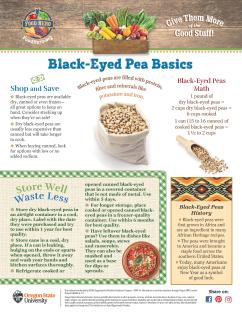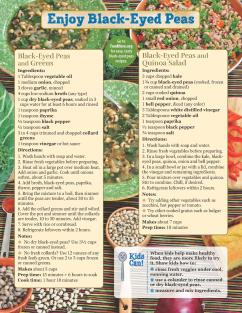Black-Eyed Pea Basics
Black-eyed peas are filled with protein, fiber and minerals like potassium and iron.
Shop and Save
- Black-eyed peas are available dry, canned or even frozen—all great options to keep on hand. Consider stocking up when they’re on sale!
- Dry black-eyed peas are usually less expensive than canned but will take longer to cook.
- When buying canned, look for options with low or no added sodium.
Store Well Waste Less
- Store dry black-eyed peas in an airtight container in a cool, dry place. Label with the date they were purchased and try to use within 1 year for best quality.
- Store cans in a cool, dry place. If a can is leaking, bulging on the ends or spurts when opened, throw it away and wash your hands and
kitchen surfaces thoroughly. - Refrigerate cooked or opened canned black-eyed peas in a covered container that is not made of metal. Use within 5 days.
- For longer storage, place cooked or opened canned black-eyed peas in a freezer-quality container. Use within 6 months for best quality.
- Have leftover black-eyed peas? Use them in dishes like salads, soups, stews and casseroles. They can also be mashed and used as a base for dips or spreads.
Black-Eyed Pea History
- Black-eyed peas were first grown in Africa and are an ingredient in many African Heritage recipes.
- The peas were brought to America and became a staple food across the southern United States.
- Today, many Americans enjoy black-eyed peas at New Year as a symbol of good luck.
Black-Eyed Peas Math
1 pound of dry black-eyed peas = 2 cups dry black-eyed peas = 6 cups cooked black-eyed peas
1 can (15 to 16 ounces) of cooked black-eyed peas = 1 1/2 to 2 cups
Enjoy Black-Eyed Peas
Recipes
Black-Eyed Peas and Quinoa Salad
Kids Can!
When kids help make healthy food, they are more likely to try it. Show kids how to:
- rinse fresh veggies under cool, running water.
- use a colander to rinse canned or dry black-eyed peas.
- measure and mix ingredients.




